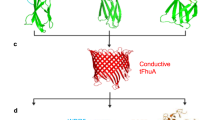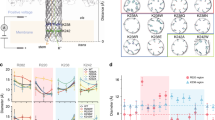Abstract
Here we describe a new type of biosensor element for detecting proteins in solution at nanomolar concentrations. We tethered a 3.4 kDa polyethylene glycol chain at a defined site within the lumen of the transmembrane protein pore formed by staphylococcal α-hemolysin. The free end of the polymer was covalently attached to a biotin molecule. On incorporation of the modified pore into a lipid bilayer, the biotinyl group moves from one side of the membrane to the other, and is detected by reversible capture with a mutant streptavidin. The capture events are observed as changes in ionic current passing through single pores in planar bilayers. Accordingly, the modified pore allows detection of a protein analyte at the single-molecule level, facilitating both quantification and identification through a distinctive current signature. The approach has higher time resolution compared with other kinetic measurements, such as those obtained by surface plasmon resonance.
This is a preview of subscription content, access via your institution
Access options
Subscribe to this journal
Receive 12 print issues and online access
$209.00 per year
only $17.42 per issue
Buy this article
- Purchase on Springer Link
- Instant access to full article PDF
Prices may be subject to local taxes which are calculated during checkout



Similar content being viewed by others
References
Heath, J.R., Kuekes, P.J., Snider, G.S. & Williams, R.S. A defect-tolerant computer architecture: opportunities for nanotechnology . Science 280, 1716–1721 (1998).
Davis, A.P. Synthetic molecular motors. Nature 401, 120–121 (1999).
Seeman, N.C. DNA engineering and its applications to nanotechnology. Trends Biotechnol. 17, 437–443 (1999).
Song, L. et al. Structure of staphylococcal α-hemolysin, a heptameric transmembrane pore. Science 274, 1859– 1865 (1996).
Gouaux, E. α-Hemolysin from Staphylococcus aureus: an archetype of β-barrel, channel-forming toxins. J. Struct. Biol. 121, 110–122 (1998).
Chang, C.-Y., Niblack, B., Walker, B. & Bayley, H. A photogenerated pore-forming protein. Chem. Biol. 2, 391 –400 (1995).
Panchal, R.G., Cusack, E., Cheley, S. & Bayley, H. Tumor protease-activated, pore-forming toxins from a combinatorial library. Nat. Biotechnol. 14, 852–856 ( 1996).
Russo, M.J., Bayley, H. & Toner, M. Reversible permeabilization of plasma membranes with an engineered switchable pore. Nat. Biotechnol. 15, 278–282 (1997).
Braha, O. et al. Designed protein pores as components for biosensors. Chem. Biol. 4, 497–505 ( 1997).
Gu, L.-Q., Braha, O., Conlan, S., Cheley, S. & Bayley, H. Stochastic sensing of organic analytes by a pore-forming protein containing a molecular adapter. Nature 398, 686–690 (1999).
Bezrukov, S.M., Vodyanoy, I. & Parsegian, V.A. Counting polymers moving through a single ion channel . Nature 370, 279–281 (1994).
Bezrukov, S.M., Vodyanoy, I., Brutyan, R.A. & Kasianowicz, J.J. Dynamics and free energy of polymer partitioning into a nanoscale pore. Macromolecules 29, 8517–8522 (1996).
Merzlyak, P.G. et al. Polymeric nonelectrolytes to probe pore geometry: application to the α-toxin transmembrane channel. Biophys. J. 77, 3023–3033 (1999).
Kasianowicz, J.J., Brandin, E., Branton, D. & Deamer, D.W. Characterization of individual polynucleotide molecules using a membrane channel. Proc. Natl. Acad. Sci. USA 93, 13770– 13773 (1996).
Akeson, M., Branton, D., Kasianowicz, J.J., Brandin, E. & Deamer, D.W. Microsecond time-scale discrimination among polycytidylic acid, polyadenylic acid and polyuridylic acid as homopolymers or as segments within single RNA molecules. Biophys. J. 77, 3227–3233 (1999).
Howorka, S. et al. A protein pore with a single polymer chain tethered within the lumen. J. Am. Chem. Soc. 122, 2411– 2416 (2000).
Sano, T. & Cantor, C.R. Intersubunit contacts made by tryptophan 120 with biotin are essential for both strong biotin binding and biotin-induced tighter subunit association of streptavidin. Proc. Natl. Acad. Sci. USA 92, 3180–3184 ( 1995).
Chilkoti, A., Tan, P.H. & Stayton, P.S. Site-directed mutagenesis studies of the high-affinity streptavidin–biotin complex: contributions of tryptophan residues 79, 108, and 120. Proc. Natl. Acad. Sci. USA 92, 1754–1758 (1995).
Chilkoti, A., Boland, T., Ratner, B.D. & Stayton, P.S. The relationship between ligand-binding thermodynamics and protein–ligand interaction forces measured by atomic force microscopy. Biophys. J. 69, 2125–2130 (1995).
Pérez-Luna, V.H. et al. Molecular recognition between genetically engineered streptavidin and surface-bound biotin. J. Am. Chem. Soc. 121, 6469–6478 (1999).
Slatin, S.L., Qiu, X.-Q., Jakes, K.S. & Finkelstein, A. Identification of a translocated protein segment in a voltage-dependent channel. Nature 371, 158–161 ( 1994).
Wong, J.Y., Kuhl, T.L., Israelachvili, J.N., Mullah, N. & Zalipsky, S. Direct measurement of a tethered ligand–receptor interaction potential. Science 275, 820–822 (1997).
Bayley, H., Braha, O. & Gu, L.-Q. Stochastic sensing with protein pores. Adv. Mater. 12, 139–142 ( 2000).
Myszka, D.G. Improving biosensor design. J. Mol. Recognition 12, 279–284 (1999).
Mao, C., Sun, W., Shen, Z. & Seeman, N.C. A nanomechanical device based on the B-Z transition of DNA. Nature 397 , 144–146 (1999).
Weiss, S. Fluorescence spectroscopy of single biomolecules. Science 283, 1676–1683 (1999).
Mehta, A.D., Rief, M., Spudich, J.A., Smith, D.A. & Simmons, R.M. Single-molecule biomechanics with optical methods . Science 283, 1689–1695 (1999).
Xie, X.S. & Lu, H.P. Single-molecule enzymology. J. Biol. Chem. 274, 15967–15970 (1999).
Marszalek, P.E. et al. Mechanical unfolding intermediates in titin molecules. Nature 402, 100–103 ( 1999).
Stayton, P.S. et al. Control of protein–ligand recognition using a stimuli-responsive polymer. Nature 378, 472– 474 (1995).
Walker, B.J. & Bayley, H. A pore-forming protein with a protease-activated trigger. Protein Eng. 7, 91– 97 (1994).
Walker, B. & Bayley, H. Key residues for membrane binding, oligomerization, and pore-forming activity of staphylococcal α-hemolysin identified by cysteine scanning mutagenesis and targeted chemical modification . J. Biol. Chem. 270, 23065– 23071 (1995).
Cheley, S., Braha, O., Lu, X., Conlan, S., & Bayley, H. A functional protein pore with a “retro” transmembrane domain. Protein Sci. 8, 1257 –1267 (1999).
Walker, B.J., Krishnasastry, M., Zorn, L., Kasianowicz, J.J. & Bayley, H. Functional expression of the α-hemolysin of Staphylococcus aureus in intact Escherichia coli and in cell lysates. J. Biol. Chem. 267, 10902– 10909 (1992).
Walker, B. & Bayley, H. Restoration of pore-forming activity in staphylococcal α-hemolysin by targeted chemical modification. Protein Eng. 8, 491–495 (1995).
Montal, M. & Mueller, P. Formation of bimolecular membranes from lipid monolayers and study of their electrical properties. Proc. Natl. Acad. Sci. USA 69, 3561– 3566 (1972).
Christopher, J.A. SPOCK: the structural properties observation and calculation kit (program manual). (Center for Macromolecular Design, Texas A&M University, College Station, TX; 1998).
Acknowledgements
We are most grateful to Pat Stayton and David Hyre for the W120A protein. This work was supported by a Multidisciplinary University Research Initiative (MURI) award (Office of Naval Research) to H.B., a MURI award (Air Force Office of Scientific Research) to A.J. Welch, the Department of Energy and the Texas Advanced Technology Program. S.H. holds a postdoctoral fellowship from the Austrian Science Foundation (Fonds zur Förderung der wissenschaftlichen Forschung). We thank Li-Qun Gu, Yong Zhang, and Sean Conlan for their help and suggestions.
Author information
Authors and Affiliations
Corresponding author
Rights and permissions
About this article
Cite this article
Movileanu, L., Howorka, S., Braha, O. et al. Detecting protein analytes that modulate transmembrane movement of a polymer chain within a single protein pore. Nat Biotechnol 18, 1091–1095 (2000). https://doi.org/10.1038/80295
Received:
Accepted:
Issue Date:
DOI: https://doi.org/10.1038/80295
This article is cited by
-
Highly shape- and size-tunable membrane nanopores made with DNA
Nature Nanotechnology (2022)
-
Polypeptide analysis for nanopore-based protein identification
Nano Research (2022)
-
Protein identification by nanopore peptide profiling
Nature Communications (2021)
-
Gold nanotubes: synthesis, properties and biomedical applications
Microchimica Acta (2020)
-
Real-time measurement of protein–protein interactions at single-molecule resolution using a biological nanopore
Nature Biotechnology (2019)



